Día de Muertos
Hi friends!
I’m Greta and I’m from Mexico.
November 2nd was Día de Muertos here in my country.
Día de Muertos means “day of the dead”. You might have heard about it, since there’ve been some movies made about the festival, and it’s an important celebration for most of us, Mexicans.
Sometimes Día de Muertos is seen as a festival akin to Halloween, due to the similar theme and the date for both being so close together. However, Día de Muertos has its own unique celebration. Halloween is a festival born from a tradition to ward off evil spirits while Día de Muertos is the day in which we invite the dead to our homes and celebrate our deceased loved ones who visit us once a year. Although both are related to ghosts and deceased people, they approach the same subject from two opposite sides.
In Mexico, both Halloween and Día de Muertos are celebrated. We do dress up on Halloween and go trick-or-treating, but we also follow closely our tradition. In most schools, the tradition of Día de Muertos is taught and celebrated, from elementary schools to universities.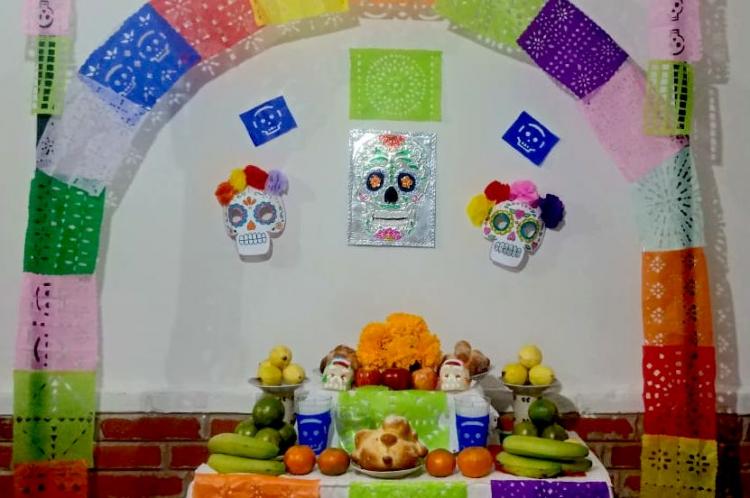
Día de Muertos originated in the indigenous traditions from the pre-Hispanic age and many of the pre-Hispanic cultures venerated gods of death.
For example, the Aztecs, or as they preferred to be called the Mexicas, the most widespread empire at the time of the Spanish conquest, believed that there are four different destinations for the dead, depending on how they had died. Two of the gods they worshipped are Mictecacíhuatl and Mictlantecuhtli, who are believed to reign over the underworld: Mictlán, where those who died of natural causes went to rest.
Back then, after someone died their family conducted rituals to help their soul to find its way safely to Mictlán, which is a trip of four years. As a part of the rituals they shroud the dead with their personal objects and objects they will need during their trip, including offerings for the gods and xoloitzcuintles, known as the Mexican hairless dog, which is believed to help them reach Mictlán.
They also had celebrations to honor the dead, on a separate day, for those who died young and for those who died after coming of age. While we kept some of our indigenous traditions even after the Spanish conquest, we also had to adapt Catholic culture to our lives.
One is Día de todos los santos (day of all saints), celebrated on November 1st, which honors all the dead who have gone to heaven. Another is Día de todos los fieles difuntos (literally translated as “day of all the faithful departed” or more commonly “all souls’ day”), celebrated on November 2nd, which honors all the dead who are still in purgatory.
As the result of both our indigenous heritage and the conquest, we have the Día de Muertos known today. On November 1st, as we call “Día de todos los santos”, we celebrate the dead children visiting us, while we celebrate the rest who visit us on “Día de todos los fieles difuntos”, the November 2nd. Both are called “Día de Muertos”.
Celebrating the return of the dead, we set up an altar and give offerings to them. Among the things we give as offering, is food. We often give fruits and a glass of water, but sometimes we also cook our dead’s favorite food as offering so that they can taste it once again when they come and visit us. In addition to that, we give a special kind of bread, called pan de muerto (“bread of the dead”). Pan de muerto is round shaped and is decorated with bone-shaped pieces on top of it. Most of them are sprinkled with sugar, but there are many other types too. For example, in my hometown, we have the pan de muerto con chochitos, the pan de muerto with little sugary balls on top, which my friends at my University in Mexico say is weird. They make fun of it because often times the chochitos (the candy) fall off, but it’s delicious. I have also seen and tried pan de muerto decorated with figs, nuts, almonds and dried fruits.
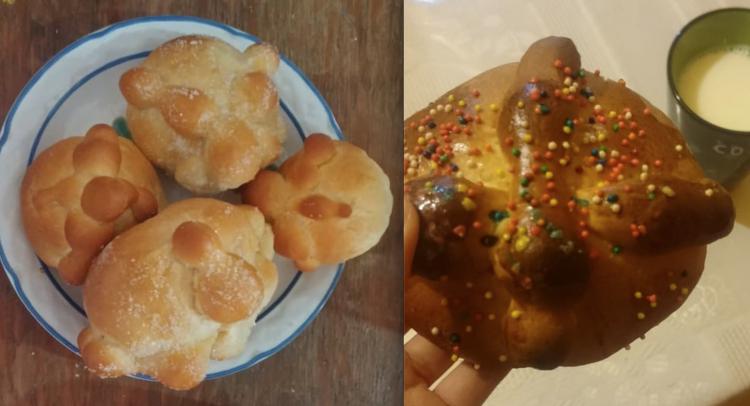
These kinds of bread are usually sold at bakeries as the dates of celebration approach. Some bakeries in my hometown sell them at the market throughout the year. Above is the photo I took last year of one I bought off-season.
I also included the bread my family baked this year! Not bad for the first time right?
I’m sure that most people agree with me that pan de muerto, is, without a doubt, one of the best things about autumn.
Another traditional food we offer along with pan de muerto is the calaveritas de azúcar. It is a skull-shaped sugar and is often decorated with candy. Often times the name of dead’s is written on its forehead with candy. There are also skulls made by chocolate or amaranth, but the sugar one is the most used. We also buy them, simply to eat by ourselves.
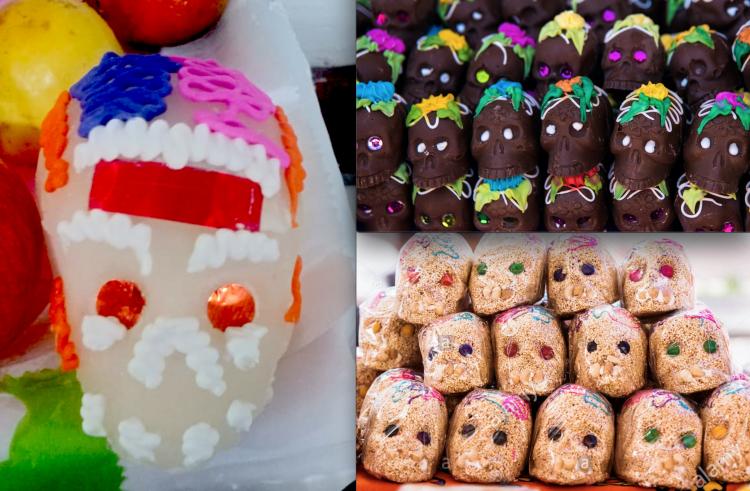
After Día de Muertos has passed and the dead have left, we are allowed to eat the offerings we gave on the alter. However, it is said that the dead suck out all the flavor of the food.
I have never eaten the offerings so I don’t know how they taste. However, some of my elementary school friends used to say, back then, that the food was indeed flavorless.
When people make big altars they fill a basket with food and candies to give them to friends so that the food doesn’t go to waste.
On the altars we also put some of the personal items our dead had in life. We leave toys for children, and for those who used to smoke cigars, some are put there, along with alcohol. We also put pictures of our deceased there.
An altar is usually set up over our dead’s grave in the cemetery, and we visit them. However, unfortunately, it’s not always possible (for example, most people were not able to visit the grave this year because of COVID-19). Children usually go trick-or-treating when they visit the cemetery. They dress up and sing songs to ask for candies, and some families ask the children to pray with them before giving them a treat. Treats, in these cases, are usually fruits and sugar canes, they can be accompanied by candy but usually are not.
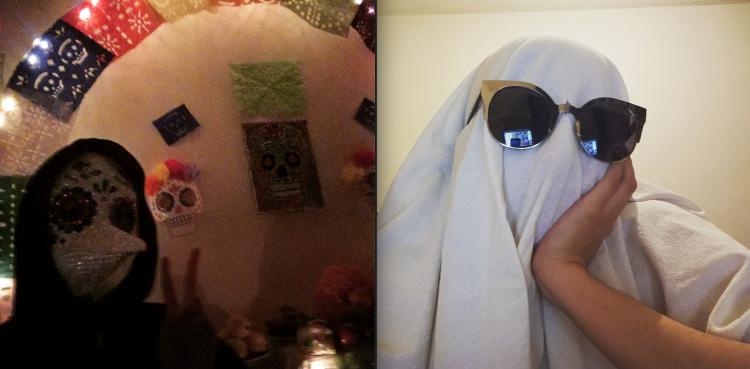
(Above are the two costumes I used in a zoom party with my friends. I was wearing the ghost costume underneath, so when I took the mask off I revealed I was a ghost.)
Usually at our homes, altars are dedicated to family members who have passed away, but in other places such as city halls and schools, altars are set up for famous people such as painters, singers, actors, and historical figures such as our Revolution and Independence heroes. At my elementary school for example, part of the altar was dedicated to the woman whom our school was named after.
We also decorate the altar with candles, papers and flowers. We use papel picado (which translates to confetti in English but isn’t the kind of confetti you throw at parties) as decoration. The papel picado, made with chinese paper, are usually made and sold by artisans, as most have complex patterns of skeletons and flowers.
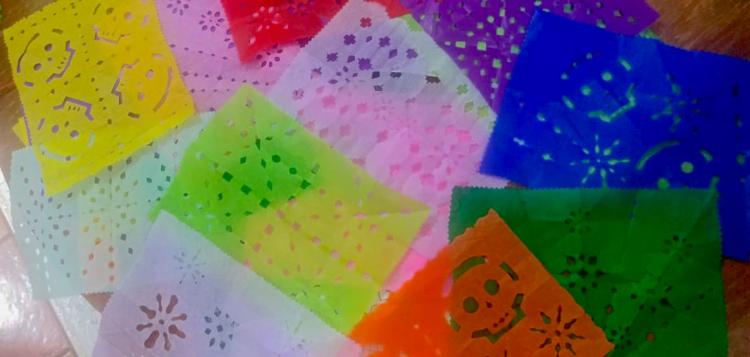
(This papel picado isn’t as elaborate as the ones artisans make, but I think my mom and my brother made really pretty designs!)
Usually altars are full of colors, but the one that pops out the most is yellow. This is because we use cempasúchitl flowers, because we believe they signal the way home for our deceased.
We usually put them on the altar, but we sometimes also make a path from the entrance of our home to the altar. Cempasúchitl are not the only flowers used, though. People also put sunflowers and flowers of other colors, but during this time of the year there are plenty of yellow wild flowers on the mountains, so some people harvest and sell them at the market. Here’s a picture of cempasúchitl and the view from my home, so you can see the wild flowers too!
Other decorations are often added, most are skeletons of different materials or paper flowers and other kinds of paper decorations. To signal that you are waiting for the souls of your loved ones, people light up a chinese paper star lamp at the entrance of their house. Most years I love walking or driving through my hometown, because lots of houses hang these lamps in the streets over their doors.
People might also cover the graves or the floor with flower or seed tapestry. Those who adhere closely to traditions also put more elements, such as big purple candles—12, to be precise, but it can be 4 put in the four cardinal directions to orient the souls—and cane arcs. Crosses are also put over the graves, made with flowers, candles, salt or ash. Those who adhere the most to the Catholic traditions have short services and pray.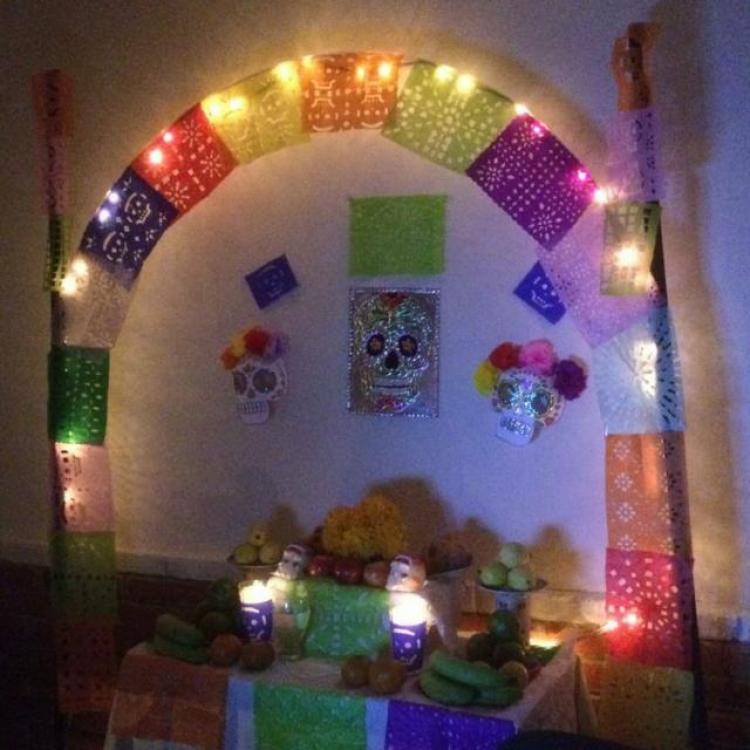
(Here’s a picture of the one my family put up this year! It’s not as big as many others, but this year we made our own Pan de muerto and papel picado for the first time!)
I mentioned before that children dress up to ask for fruits during Día de Muertos. Although their costumes can be anything, the most common one is the Catrina or the Catrín. Not only kids but adults also wear the Catrina. It’s one of the most widely known symbols of Día de Muertos, and is used in altars for decorations too. She’s written into literary pieces and I remember distinctly that every year at my elementary school, we were given prints of her to color.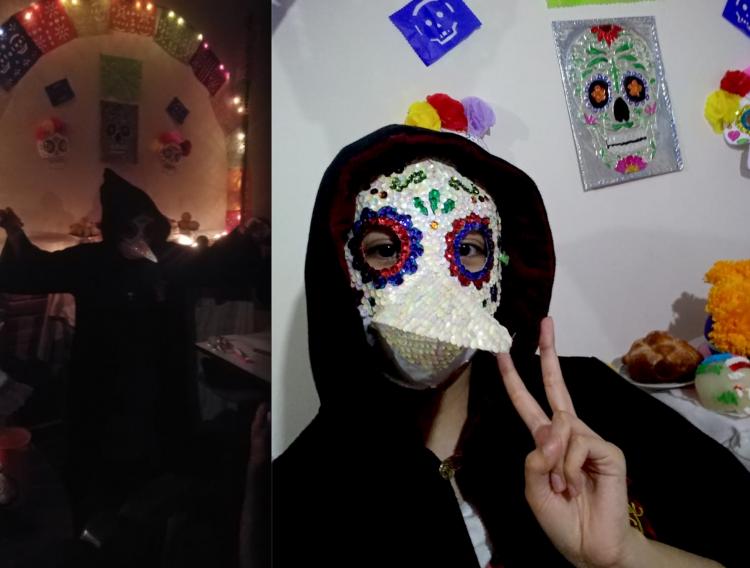
(Here’s my brother’s costume and the mask he made for us in better lighting, so you can see it clearly. He was inspired by the Catrina, and added his own twist to it by adding a bird’s beak to it. It’s not that traditional like this, but the whole tradition is the product of the evolution of tradition, so I like it quite a lot.
The Catrina and the Catrín are skeletons that are dressed elegantly. They were originally used in newspapers before the Mexican Revolution as part of satires to reflect the reality of the class division between the aristocratic and the poorest class in Mexico. The first depiction of the Catrina was drawn by José Guadalupe Posada. Since then it has been used in other forms of art such as Diego Rivera’s “Sueño de una tarde dominical en la alameda central”.
Look it up if you are interested!.
The Catrina is one of the biggest symbols that reflect the spirit of Día de Muertos. She’s often used in literary pieces called Calaveras literarias (translated as “literary skulls”. The Calaveras literarias often make fun of death. They are written in the upcoming days before Día de Muertos and are written in verse. They can be satirical, and often make fun of politics or of other people. In elementary and primary school we were even encouraged and tasked to write some, even about our teachers and classmates!
Día de Muertos is a celebration of past and present, of life and death. Families usually reunite to celebrate. My family visited my grandparents, and we would eat pan de muerto while telling stories. My grandparents told us about people who have passed away, and everyone would tell some scary stories about witches or nahuales or ghosts.
Día de Muertos is one of my favorites, if not my favorite, festival of the whole year. I love that we approach death from a fun side, accepting it as a part of life, not something to fear, but something to acknowledge and to have fun with while we are alive. I also love that it’s a way to be in touch with our past, both because it’s our heritage and because we remember our loved ones, not with sadness in our hearts, but with love and happiness to see them return to us for a little while.



